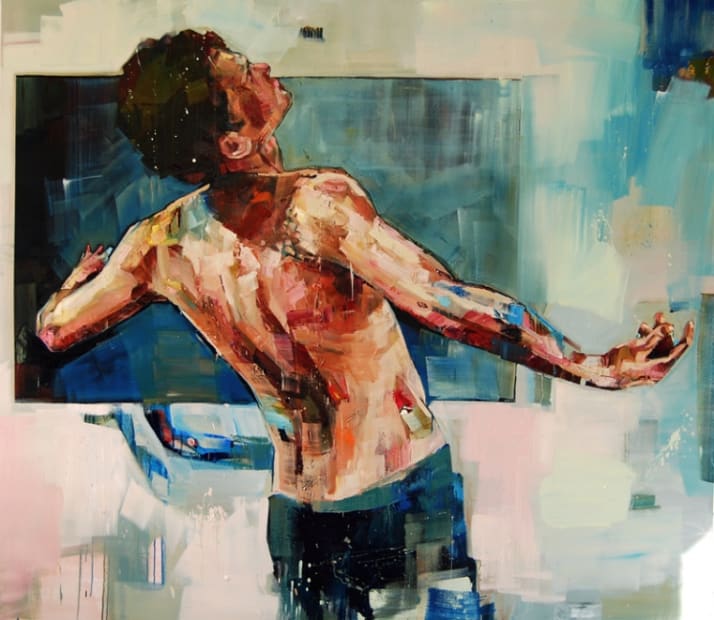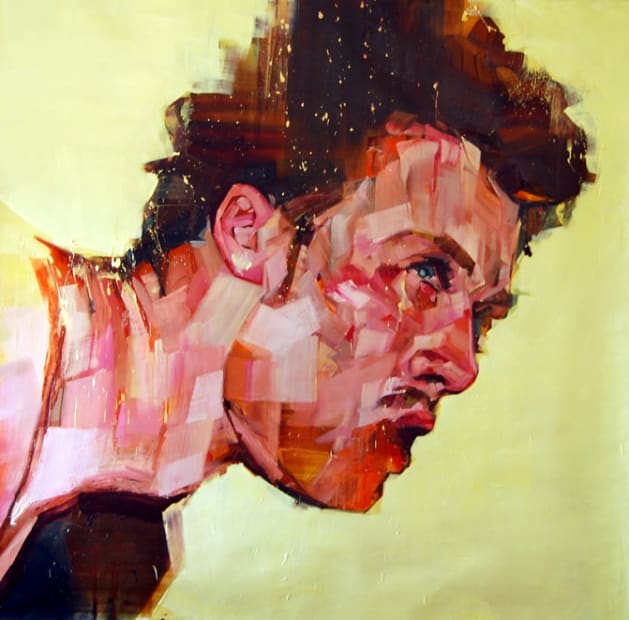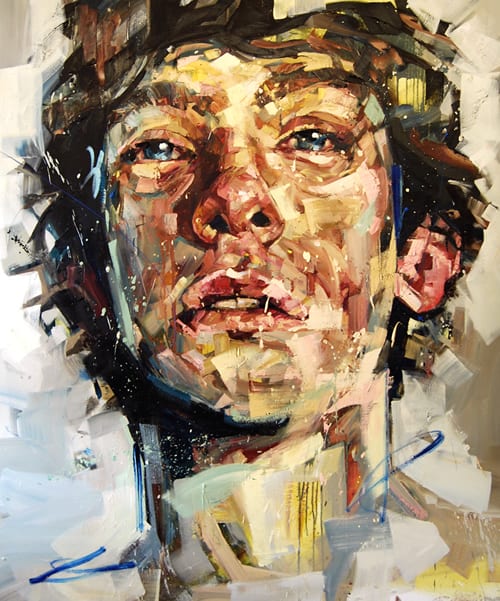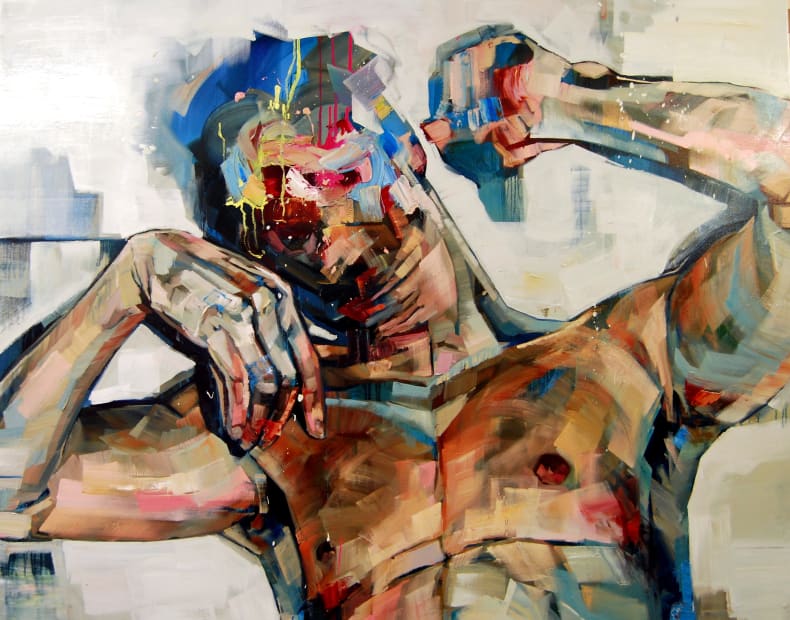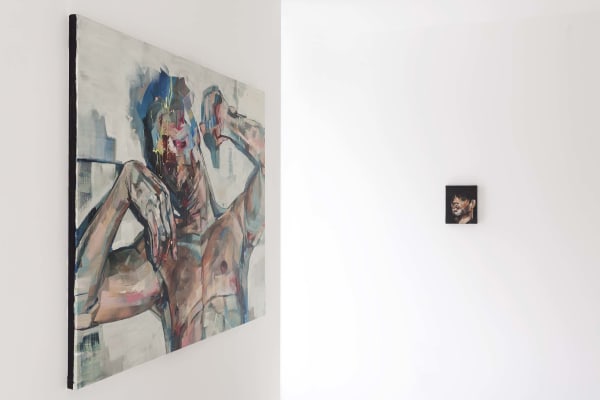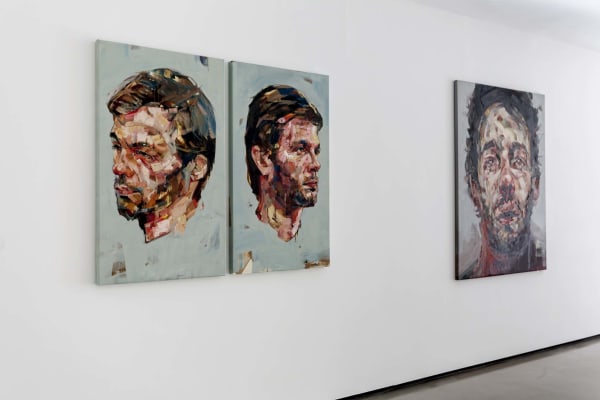ANDREW SALGADO: THE MISANTHROPE
At a time when painting itself often seems to be a threatened, even despised, form of artistic activity, Andrew Salgado emerges as a dazzlingly skillful advocate for the medium he has chosen to embrace.
– Edward Lucie-Smith, 2012
The Misanthrope is painter Andrew Salgado’s second solo exhibition with BEERS London since 2008, and Salgado credits a quote by Lucien Freud as the exhibition’s starting point, in which the late Freud stated that “the painter’s obsession with his subject is all that he needs to drive him to work.” He interprets Freud’s quote as the artist’s need to ascertain a sense of (unromantic) love for his subject, but insists upon an impassioned relationship to personal and universal narratives as the continued source that informs his practice. The concept for the exhibition arose while completing a piece entitled A Question of Profound Regret, which features reverse ‘mirrored’ portraits of gay serial-killer Jeffrey Dahmer. Salgado maintains the connection necessary between artist and subject became a source of contention while completing the aforementioned work: the question how might one empathize with such a reprehensible figure became a personal struggle that led to further questions informing The Misanthrope.
What may reveal itself to be of interest is Salgado’s insistence on the importance of the title’s semantic particularities: Salgado is very aware of both the intensity and the pejorative nature of the title, particularly for an exclusively figurative exhibition. He insists that the titular misanthrope has failed, yet the question remains whether the misanthrope has failed because of his continued and expectant distain for humankind, or has he failed because he neglects to succeed at the nature of what his name suggests? Salgado remains evasive about these narrative intentions, but suggests the misanthrope’s ultimate failure would be to experience love.
Still, the title asks the viewer to consider larger personal and societal questions than what is immediately evident through the form and/or content of the work, and ultimately, it appears to be Salgado’s affinity for narrative that propels further inquiry into the work and the extraneous questions that may occur. It appears that of greatest importance is the suggestion of optimism that prevails; Salgado seems uncompromised in highlighting the beauty (both in terms of technique and content) emanating from each painting.
Above all, one will notice Salgado’s love for his medium through an evolving technique and what is quickly becoming his signature style. His practice is a process that transforms the figure and reveres the medium of oil paint. While the works are undeniably figurative, Salgado maintains himself as more of an abstract painter, defying the conventions of the figurative painting, here noticeable through his most defiant use of a palette-knife (often in favor of the brush) to-date, and a paint-texture that appears at times both buttery and topographic. In a recent interview he is quoted as follows:
At my core I feel more like an abstract artist than a figurative artist; I avoid adhering too closely or exclusively to any term because I believe it whittles what I do to something one-dimensional, didactic, in the sense that I’ve always felt it too superficial to simply aim for likeness in representation. In this regard, it’s important for me to question the nature of the painted image, the figure, and also those concepts not-so-visibly evidenced such as masculinity, sexuality, and identity. I suppose that the way I go about drawing attention to this is by loosening the grip on accuracy; I want the viewer to be aware that they are looking at a reconstruction – a mark of paint might vaguely (or not so vaguely) represent an eye or the tip of a nose, but it also exists purely as a mark of paint, nothing else and nothing more. It is this duality of forms that I believe allows me (and hopefully the viewer) to question the painted image. In that act of questioning, the entire figure becomes questioned. For me, the fact that I don’t implicitly ‘buy in’ to the image on the canvas and am concerned about its (de)construction, prevents the work from becoming too solipsistic, self-indulgent, or banal. I like to keep things uncertain: the form, the concept, the figure itself… this is the only way my viewer is going to approach my work with an open mind and leave with their own conclusions.
WORDS BY EDWARD LUCIE-SMITH
Sometimes – not often nowadays – at a contemporary artwork, or a series of contemporary artworks, I get a shock. Very often indeed, I am not at all shocked by things that are deliberately intended to provoke the audience. A case in point would be the now half-forgotten giant portrait of the murderess Myra Hindley (Myra, Marcus Harvey, 1995), which was perhaps the chief ‘sensation’ of the Sensation! exhibition of 1997, held at the Royal Academy, which established the YBA (Younger British Artists) group in the public consciousness. The fact that the image, copied from a police ID photograph of no artistic merit in itself, had been made, not with a brush, but with a stamp moulded from a child’s hand, caused a huge stir in the press, and provoked demonstrations from relatives of the children murdered by Hindley and her partner in crime Ian Brady. Simply regarded as a painting, a work of art made by putting paint on a flat surface, the likeness of Hindley was completely inert. It had less, not more, emotional force that the photograph from which it originated.
Where did it – does it – differ from the two portraits of Jeffrey Dahmer included here, another notorious murderer, which provided the catalyst for Andrew Salgado’s exhibition The Misanthrope? What they have in common with the painting of Hindley is that they have necessarily been generated from photographs. Yet Dahmer was killed in 1994 by a fellow prison inmate; he has been dead for nearly two decades, and was never physically within the reach of the artist. What is different is the sheer freedom and individuality of the handling: it lies in the power of the paint itself to convey intertwined thought and emotion. If you want a practical demonstration of what I mean, go to the Wallace Collection, here in London, a look at one of the most celebrated masterpieces in the collection: Frans Hals’ Laughing Cavalier (1624). A very different subject, but in many ways, a very similar set of effects.
Hals belonged to a small group of major Baroque painters who were virtuosi in the use of paint, and in particular, virtuosi in creating the look of life and movement through often very loose handling of their material. Rembrandt, in his later work, belongs to the same category. So too does the mature Velazquez. That is the tradition to which the works shown here seem to belong.
Not surprisingly, however, things have moved on since the 17th century. The paintings are all heads, tightly cropped, not full length or half-length figures in the manner of Baroque portraiture. The focus is not only on the depiction of psychological states, but on the extreme rapidity with which the states can sometimes alter, like the shadows of clouds passing over a summer cornfield.
At a time when painting itself often seems to be a threatened, even despised, form of artistic activity, Andrew Salgado emerges as a dazzlingly skillful advocate for the medium he has chosen to embrace. These paintings tell us more than a video ever could about the characters whom they depict. A video narrative about the nature of misanthropy would never be even a quarter as informative. In addition, it is a narrative that we can study in our own time, at leisure. These are not paintings to be looked at only once. They do not operate within a fixed time frame. What they have to say will change from occasion to occasion, even when it is the same spectator involved.
Using a supposedly traditional medium, they are in fact contemporary in the best sense. We inhabit a society where feelings and perceptions are growing more fluid, rather than less. The paintings undoubtedly reflect that situation. However they go further, by reflecting it in a form where these changes can be held for a moment, and examined. They do not wriggle out of our grasp. Yet they always have something to add, something new to say to us.
ANDREW SALGADO
Andrew Salgado (b. 1982, Regina, Canada) has exhibited in the United Kingdom, Germany, Scandinavia, Australia, Venezuela, Thailand, Korea, Canada, and the United States. His bold, assertive, and generally large-scale figurative paintings have placed him as one-to-watch in both the UK’s and North America’s painting scenes; his recent solo exhibitions include In Order To Rebuild; Dosi Gallery, Busan, Korea (2012); and The Misanthrope; BEERS London, (2012). Forthcoming solo exhibitions include The Acquaintance, his first institution-exhibition at his home-town in The Art Gallery of Regina, Canada (Jan 2013); and solo exhibitions at La Petit Mort Gallery, Ottawa, Canada (May 2013); and One Art Space in New York City (October 2013).
Salgado’s paintings have hung in London’s Courtauld Institute of the Arts (2010) alongside Tracy Emin and Gary Hume; he was responsible for donating what became the highest-grossing work ever auctioned Canada’s esteemed (18th Annual) Art For Life Charity Auction (2011); his works were selected for the Merida Biennale of Contemporary Art (2010),;as well as the NordArt Carlshütte Biennale (2012); and he has been featured in press and magazines, such as METRO, The Independent, Shortlist, Yatzer!, Juxtapoz, Colossal, Booooooom!, Beautiful Decay, Paradigm, Chaos, TOH! Italia. In 2011 he was featured in the Channel 4 (UK) documentary What Makes A Masterpiece? alongside artists Anish Kapoor, Howard Hodgkins, and Bridget Riley (2011).
He has lived and worked in London, UK since 2008.
EDWARD LUCIE-SMITH
Edward Lucie-Smith is an internationally known art critic and historian, who is also a published poet and a practicing photographer. As a photographer he has exhibited in a wide variety of international locations, ranging from Kuala Lumpur to Rio de Janeiro and Kingston, Jamaica. He has published more than a hundred books in all, chiefly but not exclusively about contemporary art. He is generally regarded as the most prolific and the most widely published writer on art. A number of his art books are used as standard texts throughout the world. Among the languages in which they have appeared are Chinese, Arabic and Persian. He currently curates the Bermondsey Project Space in London, managed by Crisis, the charity for the single homeless. He has organised exhibitions in a number of galleries worldwide – Greece, Germany, the United States, Italy and Estonia, and most recently in Lithuania. He is the Chair of the international jury for Persbook, an annual competition for young Iranian artists held on Facebook, and has served on the juries of the Cairo, Alexandria and Sharjah Biennials.
